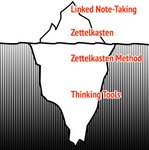
The Iceberg Theory of the Zettelkasten Method — Exploring the Depths

Even though the slip-box, being organised bottom-up, does not face the trade-off problem between too many or too few topics, it too can lose its value when notes are added to it indiscriminately. It can only play out its strengths when we aim for a critical mass, which depends not only on the number of notes, but also their quality and the way they
... See moreSönke Ahrens • How to Take Smart Notes: One Simple Technique to Boost Writing, Learning and Thinking – for Students, Academics and Nonfiction Book Writers
We have seen in the first step that elaboration through taking smart literature notes increases the likelihood that we will remember what we read in the long term. But this was only the first step. Transferring these ideas into the network of our own thoughts, our latticework of theories, concepts and mental models in the slip-box brings our thinki
... See moreSönke Ahrens • How to Take Smart Notes: One Simple Technique to Boost Writing, Learning and Thinking – for Students, Academics and Nonfiction Book Writers
He realised that one idea, one note was only as valuable as its context, which was not necessarily the context it was taken from. So he started to think about how one idea could relate and contribute to different contexts. Just amassing notes in one place would not lead to anything other than a mass of notes. But he collected his notes in his slip-
... See moreSönke Ahrens • How to Take Smart Notes: One Simple Technique to Boost Writing, Learning and Thinking – for Students, Academics and Nonfiction Book Writers
Even if you don’t aim to develop a grand theory and just want to keep track of what you read, organise your notes and develop your thoughts, you will have to deal with an increasingly complex body of content, especially because it is not just about collecting thoughts, but about making connections and sparking new ideas.